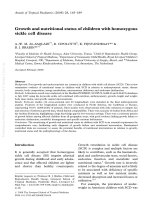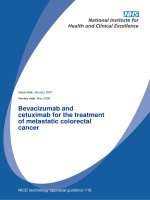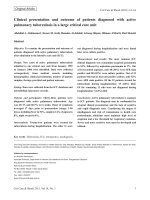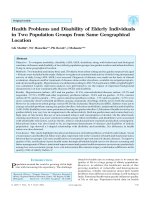Easy and effective - web-based information systems designed and maintained by physicians: experience with two gynecological projects docx
Bạn đang xem bản rút gọn của tài liệu. Xem và tải ngay bản đầy đủ của tài liệu tại đây (20.58 KB, 6 trang )
Archives of Gynecology and Obstetrics
DOI 10.1007/s00404-002-0365-9
Original Article
Easy and effective - web-based information systems
designed and maintained by physicians: experience
with two gynecological projects
M. S. Kupka( ) · C. Dorn · O. Richter · H. van der Ven · M. Baur
M.S. Kupka
Department of Epidemiology and International Health, School of Public Health, University of
Alabama at Birmingham, 1665 University Blvd., Birmingham, AL 35294-0022, USA
C. Dorn · O. Richter · H. van der Ven
Department of Obstetrics and Gynecology, University of Bonn, Germany
M. Baur
Institute of Medical Biometry, Informatics and Epidemiology, University of Bonn, Germany
E-mail:
Phone: +1-205-9757669
Fax: +1-205-9348665
Received: 16 June 2002 / Accepted: 9 July 2002 / Published online:
Abstract. It is well established that medical information sources develop continuously from printed
media to digital online sources. To demonstrate effectiveness and feasibility of decentralized
performed web-based information sources for health professionals, two projects are described. The
information platform of the German Working Group for Information Technologies in Gynecology and
Obstetrics (AIG) and the information source concerning the German Registry for in vitro fertilization
(DIR) were implemented using ordinary software and standard computer equipment. Only minimal
resources and training were necessary to perform safe and reliable web-based information sources with
a high correlation of effectiveness in costs and time exposure.
Keywords. Internet - Gynecology - Reproductive medicine - Web design
- 1 -
Introduction
It is well known that for physicians information sources change from printed media to web based
systems [6, 8, 11]. An essential reason for the rapidly acceptance and distribution of the worldwide
web (www) is the economically priced possibility to provide information contemporarily [10, 13].
This medium increasingly influences the work and decision expiry in medicine. Therefore the use of
online medical databases and expert systems were well established during the last 10 years. Especially
large data collections like medical registries attempt to present their results online to improve
effectiveness and actuality. Over 20 national medical registries have now been established in
Germany, some of them already perform data collection via electronic programs and present results
via Internet [2, 3, 7].
The most established nationwide medical registry in Germany is the Perinatal Registry, which collects
maternal health records concerning pregnancy, delivery and perinatal outcome from now more than
1100 hospitals. Over the past 16 years, data collection was transformed from printed questionnaires to
digital records. A special web-based information source of the German Perinatal Registry does not
exist. Therefore the Internet platform of the German Working Group for Information Technologies in
Gynecology and Obstetrics (AIG) offers a related panel to support technical development and release
of the actual dataset-description. In general the objectives of AIG are the introduction and
development of digital tools for quality assessment in Obstetrics and Gynecology and utilization of
new digital developments for patients, in science and teaching [12].
The second example is the German Registry for in vitro fertilization (DIR), which collects data from
now 100 IVF units in Germany [7]. Since 1990 a digital record system based on a nationwide uniform
template has been introduced. This uniformity is quite unusual in Germany due to territorially defined
autonomy in the health care system. Structure and extent of the registry are similar to the Human
Fertilization and Embryology Authority (HFEA) in the United Kingdom and the Society for Assisted
Reproductive Technology (SART) in the United States. The described Internet platform is a private
initiative to improve knowledge and to support development of electronic tools for data collection in
reproductive medicine in Germany [9].
The aim of the study was to demonstrate the effectiveness and feasibility of web-based information
sources created with a low budget and simple tools. One of the most reasonable criteria for such an
evaluation is the measurement of the platform visits per month with the particular page views
representing a prevalent method of evaluation correlated to contentment of the visitors [5, 10]. An
inquiry of the working hours invested for the maintenance of the sites and the update frequency
represents the other main outcome measurement.
Material and methods
The two Internet platforms were created in October 1998 using a standard web-design software (Front
Page 2000, Microsoft). The Department of Information Research of the University of Bonn offered a
fixed amount of memory on the hard disc drive of one Internet-server with password-protected access.
Three persons working at different institutions; two physicians and one public health professional
update the AIG web sites. Not more than one physician manages the DIR platform.
Only simple hypertext-mark up-language commands were used and a modern frame-based design,
which was tested by colleagues in order to guarantee a user-friendly environment. of the department
concerning usability and design. No Java-applets (computer language developed from Sun
Microsystems), scripts or animated plug-ins were used. No "cookies" (small amounts of information
- 2 -
stored by a web-browser software on the workstation) were created. Other peculiarities of the sites are
that the systems are updated frequently, that advertising is not a source for funding and that the
webmasters’ work is unsalaried. Privacy policy is implemented through different guarantees.
Publication of personal information is dependent from a personal written agreement, for example, for
the member list of AIG. The principles of the Health-On-the-Net-Foundation (HON) are implemented
by both websites. These principles include processing by medically trained and qualified professionals,
respect of the legal requirements of health information privacy which apply in the country and state
where the web-sites are located, confidentiality of data relating to individual persons and transparency
of authorship.
For evaluation of effectiveness and feasibility of the two platforms a commercial Internet service was
introduced from October 1999 to September 2001 measuring the number of visitors (hits) and the
content most frequently requested (page views). Normally one visit includes multiple page views.
Both items are well known indicators for acceptability and quality. The update frequency per month
and the average hours of maintenance per person were also analyzed.
Results
During the evaluation period of 24 months the service reported 10,442 visits for the platform of the
German Working Group for Information Technologies in Gynecology and Obstetrics with a total of
54,298 page views (Table 1). An average number of 435 visits per month and 5.2 page views per visit
were counted. Visitors searched most frequently for information offered by the new working group
concerning the introduction of the Australian diagnosis-related group (DRG) system in Germany or for
information offered by the panel of the Perinatal Registry. Each webmaster spent an average number
of 6.5 h per month for maintenance.
Table 1. Page views and maintenance of the two Internet platforms AIG and DIR
- 3 -
Web site content
Established
since
Update
frequency per
month
a
Working hours
per month per
person
Page views
per months
Percentage of
page views
AIG current
information
b
October
1998
2 1.5 (1-3)
267
(225-294)
11.8 (9.9-12.9)
AIG annual
meetings
October
1998
0.2 0.5 (0-1.5)
252
(136-359)
11.1 (6.0-15.9)
Panel of the German
Perinatal Registry
January
1999
1 1.5 (1-2.5)
387
(261-627)
17.1
(11.5-27.7)
Panel of the working
group DRG
March 2000 3 1.5 (1-3)
524
(464-568)
23.2
(20.5-25.1)
AIG useful links
October
1998
2 1 (0.5-2)
379
(253-421)
16.8
(11.2-18.6)
AIG member list June 1999 1 0.5 (0-1)
187
(142-284)
8.3 (6.2-12.6)
DIR technical
instructions for data
export
c
February
1999
0.2 0.5 (0-1)
196
(174-241)
27.6
(24.5-34.1)
DIR useful links
November
1998
2 1 (0.5-1.5)
204
(156-274)
28.8
(22.1-38.7)
DIR contact person
information
October
1998
0.5 0.5 (0-1)
164
(149-189)
23.1
(21.0-26.7)
a
Evaluation period October 1999-September 2001
b
; overall 10,442 visits, only pages with more than 180 views per month are
listed
c
; overall 3,618 visits, only pages with more than 150 views per month are
listed
For the German Registry for in vitro fertilization platform the service reported 3.618 visits during
which 17,004 pages of content were observed. An average of 149 visits per month and 4.7 page views
per visit were counted. Maintenance demand 2 h each month. Visitors most frequently used the link
library offered by the DIR platform and the website for technical instructions concerning the software
for data collection, respectively.
Discussion
Web-design is no longer solely dependent on sophisticated technical equipment and professional
knowledge [1, 2]. Software tools for web design were specially developed for professional users but
progress in hardware development and common software packages at the present time make it easy
also for private persons to create online information sources. The two described Internet platforms for
physicians and health professionals were designed and updated with effectiveness in terms of money,
time and equipment. Compared to other platforms concerning more common health related items a
rate of 435 visits per month on average is relatively high. A pilot project for the evaluation of
- 4 -
alcoholism, for example, reported a rate of 500 hits per month [4]. The frequency increases
dramatically if the target group is extended to a nonprofessional audience [10]. An Internet platform
offering basic information about asthma described a frequency of 9,000 visitors per month [14]. It is
interesting to note that the creation of health related information sources is mostly dependent on
content specific knowledge rather than on expensive commercial web design. Concerning the numbers
of hits, it has to be taken into consideration that health professionals represented the target groups for
both platforms with interest in specific information technology related issues of gynecology and
obstetrics. The frequency of page visits is therefore not comparable to commercial health related
platforms. On the other hand for both systems no other web-based source covered the same content.
Most of the visitors searched for information concerning software solutions related to gynecology,
oncology, obstetrics or reproductive medicine. Presentation of the new dataset description of the
Perinatal Registry has shown the highest visitor frequency. The introduction of the Australian DRG
system in Germany also caused an increase of page visits due to specific technical information offered
on the system.
Normally two different strategies are used for implementation of web sites for healthcare
organizations; the exclusively use of in-house resources or outsourcing services. Nonprofit
organizations prefer the in-house maintenances with a period of less than 10 h per week on average
[13].
The conclusion of the study is that only a minimum of technical resources and training are needed to
create safe and reliable web-based information sources in health related fields.
References
1.Adelhard K (2001) Quality assurance of medical information in the Internet-challenges for a seal of
approval in gynecology. Zentralbl Gynakol 123:458-459
2.Benjamin I, Dilling T, Goldwein J (1997) Administration of a World Wide Web site during a period
of rapid growth - the OncoLink experience. MD Comput 14:365-370
3.Cohen J (2001) The future of international registries for assisted reproductive technologies. Fertil
Steril 76:871-873
4.Cunningham JA, Humphreys K, Koski-Jannes A (2000) Providing personalized assessment feedback
for problem drinking on the Internet: a pilot project. J Stud Alcohol 61:794-798
5.Eysenbach G, Diepgen TL (1998) Evaluation of cyberdocs. Lancet 352:1526
6.Feingold M, Kewalramani R, Kaufmann G (1997) Internet and obstetrics and gynecology. Acta
Obstet Gynecol Scand 76:718-724
7.Felberbaum R, Dahncke W (2000) The German IVF Registry as a quality assurance tool and for use
in patient counseling. Gynakologe 33:800-811
8.Hamberger L, Sjoqvist B (1994) The information technology revolution - how it may affect
gynecology and obstetrics. Int J Gynaecol Obstet 47:211-213
9.Kupka MS, Dorn C, van der Ven H (2002) Development of electronic data-collection as a tool for
quality assessment in reproductive techniques in Germany. Reprod Technol 10:332-334
- 5 -
10.McDaniel L (2001) How to create and maintain a Web site for your customers. Lessons learned
from 3 experts in the field. Biomed Instrum Technol 35:339-340
11.McKeown MJ (1997) Use of the Internet for obstetricians and gynecologists. Am J Obstet Gynecol
176:271-274
12.Seufert R, Goerke K (1997) The study group for Information Processing in Gynecology and
Obstetrics-Section of the German Society of Gynecology and Obstetrics e. V (AIG): responsibilities
and current projects. Zentralbl Gynakol 119:396-397
13.Turisco F, Kilbridge PM (2000) Developing a value-added Web site. Healthcare Finan Manage
54:40-46
14.Wjst M (2001) When air is rare: behind the scenes of an asthma web site J Asthma 38:399-404
- 6 -









